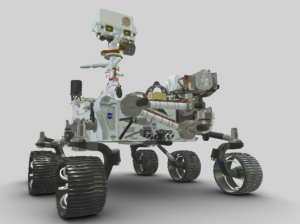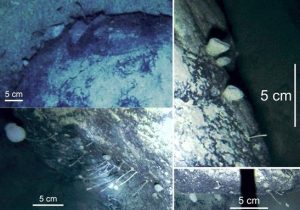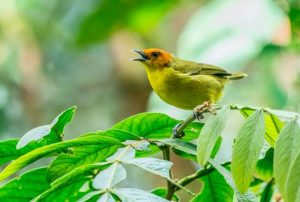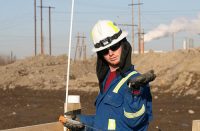There’s a New Robot on Mars

Source: NASA
NASA has successfully landed its Perseverance rover in a deep crater near the planet’s equator called Jezero. Jezero is thought to have held a giant lake billions of years ago – where there’s been water, there’s the possibility that there might have also been life. Billions of years ago, when Mars was wetter, Jezero held a lake that could have supported primitive microbial organisms. The six-wheeled car-sized rover carries a suite of science instruments designed to detect signatures of fossilised life if it’s there and will spend at least the next two years drilling into the local rocks, looking for evidence of past life, collecting data on the geology and climate of Mars, and ultimately helping us prepare for human exploration.
This mission represents NASA’s most ambitious search for signs of life on Mars since the Viking missions back in the 70s. You may remember hearing about the Viking missions. This mission is different because previously, Jezero was not a possibility for Mars rovers because there are too many landing hazards – a lot of sand, a lot of rocks, and a fair number of cliffs. Mars 2020 has something called “Terrain Relative Navigation” where it’s possible to divert away from hazards, allowing NASA to consider Jezero as a possible landing site. Using this new technology, NASA was able to very quickly see where the rover landed. You can watch the landing live here.
Newly Discovered Life Under Antarctica’s Ice Shelves

Source: NBC News
A new discovery has been made by scientists who were taking sediment ice cores from the seafloor, almost half a mile beneath floating Antarctic ice. They drilled a hole through 3000-foot-thick ice and lowered a camera into it, but they hit a rock at the bottom instead of the seafloor. The geologists could not obtain sediment samples, and instead, found something else that they did not expect.
Their camera captured images of a type of sea creature that was living in the extreme environment under the ice. Biologists believe the animal to be a type of sponge since they were stationary, appearing to be attached to a rock.
Huw Griffiths, marine biologist and lead author of the study, said, “The only things you would expect to find … are things that can wander around and find food, whereas, if you’re stuck to a rock and you’re waiting for food to come to you, then the one bit that comes past this year could go past you.” It would be impossible for plant life to photosynthesize down in the ice with no sunlight and Griffiths estimated the nearest plant life to be “up to 1000 miles away.” In order to survive, the organisms would have to feed on floating material from other animals passing by, but the details of its survival are still a mystery.
“There are still things that we have to learn,” Griffiths said. “There are still animals out there that can break the rules that we have written for them.” What a cool discovery to show how life can manifest in the deepest, coldest places of the Earth and exist in places we never thought it could!
Sawfish Are Facing Extinction

Source: Unsplash
Sad news incoming…The remarkable sawfish is now one of the most endangered fish in our oceans. It was found to be present in over 90 coastlines, and now that number is below half of that according to new studies.
Their unique fins that resemble a hedge trimmer – which were used to sense and attack prey, are now giving them another disadvantage of being easily tangled in fishing gear. With habitat loss adding to the diminishing numbers of these species. The sawfish fins and teeth are a hot commodity on the market – often being sold as trophies, food, medicine, and spurs for cockfighting.
Three of the five species of sawfish are critically endangered, and the other two are endangered according to the International Union for Conservation of Nature’s (IUCN) Red List of Threatened Species. With being considered extinct in 44 nations. With the U.S. and Australia to be considered the “lifeboat nations” where the species have more protection and higher population.
If urgent action is taken in these listed countries, it could make a big difference in restoring population numbers. They are: Cuba, Tanzania, Colombia, Madagascar, Panama, Brazil, Mexico, and Sri Lanka. It could help restore over 70% of their historical population range – only if we act now.
High-Altitude Birds Are Growing Thicker Coats to Adapt

Source: Unsplash
Evolution happening before our eyes – 250 species of Himalayan songbirds have shown their feathers evolved to suit higher altitudes and a colder environment. The birds in higher altitudes had more feathers and fluffier down – created a thicker coat for the species.
This provides identifying factors of which species pose a high risk from climate change. Dr. Sahas Barve examined the feathers of approximately 2000 birds in microscopic detail and concluded that there is a pattern between their feather structure and their habitat.
The feather is made up with an outer and a hidden down portion, those at higher elevations have shown to have flufflier down parts to their feathers. With smaller birds also displaying to have longer feathers. Dr. Barve states, “We’ve been using down jackets for a long time, but we haven’t understood how those feathers work on a bird.”
Rare Metals in Children’s Toys and Food Packaging

Source: Word Disk
Rare earth elements (REEs), along with bromine and antimony, are often used in making smartphones and are used as flame retardants in electrical equipment. Now, these rare metals are being found in everyday consumer plastic items, like children’s toys and food packaging. Should we, as consumers, be concerned about this?
Scientists from the University of Plymouth and University of Illinois tested many new and used products including children’s toys, office equipment, and cosmetic containers. The results showed that one or more REEs were in 24 of the 31 products tested. REEs have also been found in beached marine plastics, so the authors of the study suggest that there is evidence that REEs have contaminated both current and historical consumer and environmental plastics.
Dr. Andrew Turner, lead author of the study from the University of Plymouth, said: “Rare earth elements … are not deliberately added to plastic to serve any function. So their presence is more likely the result of incidental contamination during the mechanical separation and processing of recoverable components.” Turner went on to say, “The health impacts arising from chronic exposure to small quantities of these metals are unknown. But they have been found in greater levels in food and tap water and certain medicines, meaning plastics are unlikely to represent a significant vector of exposure to the general population. However, they could signify the presence of other more widely known and better-studied chemical additives and residues that are a cause for concern.” Looks like we had better keep an eye out for future studies on plastics’ secret dark side.
Is Canada’s Carbon Tax Working? What Do the Experts Have to Say?

Source: Pexels
It’s a step in the right direction to put a price on pollution and reduce carbon emissions. But is the carbon tax actually working? The Canadian Taxpayers Federation says the short answer is no. Kris Sims, the British Columbia director of the Canadian Taxpayers Federation, points to the province’s own carbon tax, which has been in place since 2008, as an example. “British Columbia has the highest carbon tax in Canada, we are at $40 per tonne. It’s about 8.3 cents per litre of gasoline,” Sims explains. Sims goes on to say that the federal government said the carbon tax would reduce emissions, but instead emissions are going up in B.C., and that’s based on the government’s own data. “Emissions in British Columbia have gone up 10 per cent in the last three years and five of the last seven years.” Sims says it’s likely a similar scenario in provinces under the federal carbon tax program, as the Trudeau government used the B.C. program as a model.
Some economists feel differently, arguing that the carbon tax is helping fight climate change, but it’s too soon to know just how the carbon tax will affect emissions in the long run. University of Calgary associate professor of economics, Trevor Tombe, weighs in, explaining that it can take years to understand the larger picture and we should be looking at the short-term. He contends that we should also be looking for changes in home heating natural gas usage and reductions there can be achieved by increased penetration of smart thermostats that can adjust the temperature when you’re not at home.












